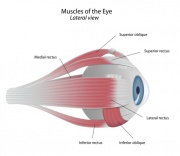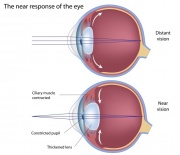Contents |
Exercise Your Eyes for Optimum Performance
Introduction
Most of us realize that exercise helps us keep our muscles flexible and efficient, but we don’t usually think about how the muscles that control the movement of the eyes or those that help us change focus from distant objects to close-up reading materials could also benefit from a short workout now and then.
While these exercises won’t allow us to get rid of our glasses (if we use them) or replace our annual vision examination, they will help to keep our eye muscles from becoming stiff and inflexible. Reading or using a computer for extended periods are two activities that may cause our eye muscle systems to mal-adapt to those stresses by becoming our “normal” ocular conditions.
Mal-adaptation to prolonged nearpoint stress has been implicated in the onset and/or progression of myopia (nearsightedness); if we keep the eye muscles moving freely and easily, we could reduce future eyestrain and improve the ability to focus and concentrate when we need to do so.
Exercises for improving visual skills are useful for three different types of tasks: convergence, rotations and accommodating (focusing skills).
Do these exercises while wearing your eyeglasses or contact lenses if you use them.
Convergence
The ability to converge our eyes, or aim them inward, is important to help us keep our eyes aimed properly at the task we are performing. Without it, we would either see double, or suppress the central vision in one eye so as to avoid it. (No, your eyes will not become stuck that way) People with poor convergence often have trouble with extended reading or other near tasks because they begin to see double as they continue; if you cannot converge your eyes closer than your normal reading distance (usually about 16 inches away from the eyes) it becomes difficult to maintain single vision.
Stand or sit in a relaxed posture. Hold a pencil at arm’s length and focus both eyes on the tip, then slowly begin to move the pencil straight in towards the eyes, keeping both eyes aimed at the pencil as it approaches the bridge of your nose. Be very aware of any tendency to see double; if the pencil begins to break into two, reverse the pencil and try to bring the two images together again. Once you have done so, bring the pencil in closer again.
If the pencil tip becomes blurry, that’s okay, but be careful that it doesn’t split into two images.
The goal here is to be able to converge your eyes without seeing double to within two or three inches of your eyes, without experiencing double vision and without strain. Repeat this at least ten times. If it is difficult to maintain single vision, practice several times a day until you get so you can follow the pencil right up to the bridge of your nose. If this exercise is difficult for you, once you build the skills to perform it well, you will probably notice that it is much easier to read for extended periods of time without strain.
Rotations
Smooth, accurate tracking skills allow us to expend less energy to keep objects in view; in other words, we should move our two-ounce eyeballs rather than our 15-pound head. People with poor tracking skills experience discomfort and eyestrain when they are required to track the words across a page of print, or follow a computer cursor across the screen.
(Right: The muscles that control eye movements can become stiff and make rotating the eyes uncomfortable.)
Sit or stand in a relaxed posture. Cover one eye with a spoon or similar object, so you cannot see around it and hold a pencil about 12 to 14 inches away with the other hand. Focus on the tip of the pencil while you move it slowly from side to side in an arc, so it stays about the same distance away. Without moving your head, follow the tip of the pencil, but be careful not to move your head. Practice following the pencil tip with your eyes as you move it in all directions of gaze, from left to right and back, up and down, and on the diagonal. After repeating ten to twenty times, switch eyes and repeat; often, people find that their tracking ability is better in one eye than the other. If you experience this, practice more with the eye that isn’t as skilled until you feel that the eyes are about equal, then, do the exercise with both eyes, again without moving your head.
As with the convergence exercises, be careful that the pencil does not split into two. It’s okay if the tip of the pencil is blurred, however. It is normal also for people with poor rotational skills to experience pulling or strain while doing these exercises, but these should disappear as you begin to build flexibility into your tracking skills.
Accommodation
Accommodation is just another word for changing your focus, from far away to close up and back again.
As we get older, it gets more difficult to change focus because the lens inside the eye is getting thicker and heavier with each passing year. This is a normal process called presbyopia, which affects almost all of us, no matter how much or how little we read.
When we are young, however, especially when still in school, being able to change focus easily from the chalk board or overhead projector to the book or computer screen is an important skill; people with poor accommodation often become “stuck” at one focal distance so as to make it easier to maintain clarity at that distance, usually our normal reading distance, about 16 inches away from our eyes.
Stand or sit in a comfortable position. Focus your eyes on a distant target, which can be a calendar page or the numbers on a clock, for example. Hold a pencil (with writing on it) or an example of small print like that found on the package inserts for medications or something of similar size. Quickly shift your focus from the calendar number to one of the letters on the pencil, trying for a fast and accurate shift of both your gaze and clarity, then switch back to the distance again.
People with poor accommodation experience difficulty in getting near reading materials into focus, and then maintaining their clarity over time. Improvement of these skills allows easier reading with less stress. Repeat these ten to twenty times, also.
These accommodation exercises will be helpful to those under the age of about 35 years.
(Above: Diagram showing muscles that control focusing at different distances.)
Good Visual Skills Essential
We can make it easier to read and maintain clear vision if we keep the muscles both inside the eye that control focusing and those outside that control eye movements in top condition. The ability to keep the reading material single, track accurately across a page and to keep it all in focus will make it easier to concentrate and comprehend what we read.
During the day, it is also very helpful to take breaks every twenty minutes or so; look up from your book or computer and re-focus your eyes outdoors. The overall goal of all these exercises is to keep our visual skills flexible and effortless, not stiff and difficult.
In some cases, these simple exercises can help us to keep our visual skills flexible and efficient; however, it is important to have regular vision exams throughout life, just as we would get a physical exam or a dental checkup on a routine basis. Vision is widely held to be our most important sense and we should not hesitate to discuss any questions or concerns with an eyecare practitioner.







